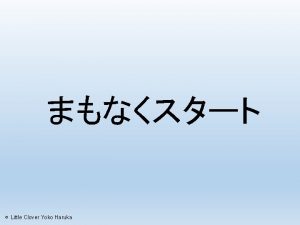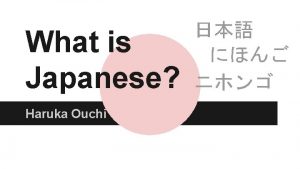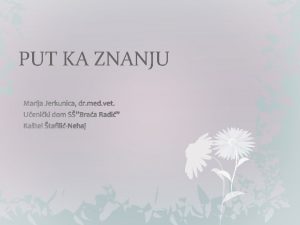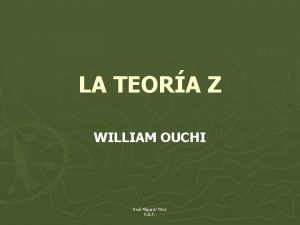put palms together Haruka Ouchi WLC 212 April











- Slides: 11

合掌:put palms together Haruka Ouchi WLC 212 April 26, 2015

What is 合掌(gassyou) 合掌 to put one’s palms together primary out of awareness

History: religious idea The idea of 合掌 right hand = yourself left hand = Budda / gods Putting palms shows becoming together with Buddha, gods and any living things.

History in Japan is agricultural society 手を染める 手を砕く 手が回る Many idioms using “hand”

Where is it found? appreciate ask a favor apology

Beyond the initial frame ・The action is used before/ after having a meal. ・The Japanese say itadakimasu(いただきます) and gochisousama (ごちそ うさま)

Beyond the initial frame express the understanding that we eat is provided by nature and will be part of our bodies. We never forget to give thanks for the connection among the human beings and among the nature (Kawano 98). Yumiko Kawano “Spirituality and Indigenous knowledgement”

Observation from other culture ● There is no appropriate translation of いただきます and ごちそうさま. ● Some European languages have similar words to appreciate for having a meal. ● It appreciates the God or means “enjoy a meal”. ● In the Christian society, it looks familiar to clasp hands.

Conclusion ● 合掌 (putting hands together) shows Asian culture based on the Buddhist idea. ● Japanese people use the action not only to pray but also to apology, appreciate and ask a favor. ● The Japanese use it to thank all living things for providing energy. ● This is the Japanese unique culture.

References Kawano, Ymiko. “Spirituality and Indigenous Knowledges. ” Spirituality, Education and Society. (2011): 97 - 110 Kotobank website https: //kotobank. jp/ Rinzai Zen website http: //www. rinnou. net/cont_04/rengo/2005 -06. html Ryusuke, Isi. “The Idea of “Overlaying” and “Divorcing”. ” The Japan Association of the Language and Culture. (2010): 249

Thank you for listening !!!



















